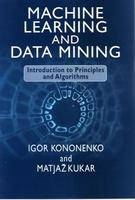
Machine Learning and Data Mining
Horwood Publishing Ltd (Verlag)
978-1-904275-21-3 (ISBN)
Data mining is often referred to by real-time users and software solutions providers as knowledge discovery in databases (KDD). Good data mining practice for business intelligence (the art of turning raw software into meaningful information) is demonstrated by the many new techniques and developments in the conversion of fresh scientific discovery into widely accessible software solutions. This book has been written as an introduction to the main issues associated with the basics of machine learning and the algorithms used in data mining.Suitable for advanced undergraduates and their tutors at postgraduate level in a wide area of computer science and technology topics as well as researchers looking to adapt various algorithms for particular data mining tasks. A valuable addition to the libraries and bookshelves of the many companies who are using the principles of data mining (or KDD) to effectively deliver solid business and industry solutions.
Igor Kononenko studied computer science at the University of Ljubliana, Slovenia, receiving his BSc in 1982, MSc in 1985 and PhD in 1990. He is now professor at the Faculty of Computer and Information Science there, teaching courses in Programming Languages, Algorithms and Data Structures; Introduction to Algorithms and Data Structures; Knowledge Engineering, Machine Learning and Knowledge Discovery in Databases. He is the head of the Laboratory for Cognitive Modelling and a member of the Artificial Intelligence Department at the same faculty. His research interests include artificial intelligence, machine learning, neural networks and cognitive modelling. He is the (co) author of 170 scientific papers in these fields and 10 textbooks. Professor Kononenko is a member of the editorial board of Applied Intelligence and Informatica journals and was also twice chair of the programme committee of the International Cognitive Conference in Ljubliana. Matjaz Kukar studied computer science at the University of Ljubliana, Slovenia, receiving his BSc in 1993, MSc in 1996 and PhD in 2001. He is now the assistant professor at the Faculty of Computer and Information Science there and is also a member of the Artificial Intelligence Department at the same faculty. His research interests include knowledge discovery in databases, machine learning, artificial intelligence and statistics. Professor Kukar is the (co) author of over 50 scientific papers in these fields.
Foreword
Preface
Acknowledgements
Chapter 1: Introduction
1.1 THE NAME OF THE GAME
1.2 OVERVIEW OF MACHINE LEARNING METHODS
1.3 HISTORY OF MACHINE LEARNING
1.4 SOME EARLY SUCCESSES
1.5 APPLICATIONS OF MACHINE LEARNING
1.6 DATA MINING TOOLS AND STANDARDS
1.7 SUMMARY AND FURTHER READING
Chapter 2: Learning and Intelligence
2.1 WHAT IS LEARNING
2.2 NATURAL LEARNING
2.3 LEARNING, INTELLIGENCE, CONSCIOUSNESS
2.4 WHY MACHINE LEARNING
2.5 SUMMARY AND FURTHER READING
Chapter 3: Machine Learning Basics
3.1 BASIC PRINCIPLES
3.2 MEASURES FOR PERFORMANCE EVALUATION
3.3 ESTIMATING PERFORMANCE
3.4 *COMPARING PERFORMANCE OF MACHINE LEARNING ALGORITHMS
3.5 COMBINING SEVERAL MACHINE LEARNING ALGORITHMS
3.6 SUMMARY AND FURTHER READING
Chapter 4: Knowledge Representation
4.1 PROPOSITIONAL CALCULUS
4.2 *FIRST ORDER PREDICATE CALCULUS
4.3 DISCRIMINANT AND REGRESSION FUNCTIONS
4.4 PROBABILITY DISTRIBUTIONS
4.5 SUMMARY AND FURTHER READING
Chapter 5: Learning as Search
5.1 EXHAUSTIVE SEARCH
5.2 BOUNDED EXHAUSTIVE SEARCH (BRANCH AND BOUND)
5.3 BEST-FIRST SEARCH
5.4 GREEDY SEARCH
5.5 BEAM SEARCH
5.6 LOCAL OPTIMIZATION
5.7 GRADIENT SEARCH
5.8 SIMULATED ANNEALING
5.9 GENETIC ALGORITHMS
5.10 SUMMARY AND FURTHER READING
Chapter 6: Measures for Evaluating the Quality of Attributes
6.1 MEASURES FOR CLASSIFICATION AND RELATIONAL PROBLEMS
6.2 MEASURES FOR REGRESSION
6.3 **FORMAL DERIVATIONS AND PROOFS
6.4 SUMMARY AND FURTHER READING
Chapter 7: Data Preprocessing
7.1 REPRESENTATION OF COMPLEX STRUCTURES
7.2 DISCRETIZATION OF CONTINUOUS ATTRIBUTES
7.3 ATTRIBUTE BINARIZATION
7.4 TRANSFORMING DISCRETE ATTRIBUTES INTO CONTINUOUS
7.5 DEALING WITH MISSING VALUES
7.6 VISUALIZATION
7.7 DIMENSIONALITY REDUCTION
7.8 **FORMAL DERIVATIONS AND PROOFS
7.9 SUMMARY AND FURTHER READING
Chapter 8: *Constructive Induction
8.1 DEPENDENCE OF ATTRIBUTES
8.2 CONSTRUCTIVE INDUCTION WITH PRE-DEFINED OPERATORS
8.3 CONSTRUCTIVE INDUCTION WITHOUT PRE-DEFINED OPERATORS
8.4 SUMMARY AND FURTHER READING
Chapter 9: Symbolic Learning
9.1 LEARNING OF DECISION TREES
9.2 LEARNING OF DECISION RULES
9.3 LEARNING OF ASSOCIATION RULES
9.4 LEARNING OF REGRESSION TREES
9.5 *INDUCTIVE LOGIC PROGRAMMING
9.6 NAIVE AND SEMI-NAIVE BAYESIAN CLASSIFIER
9.7 BAYESIAN BELIEF NETWORKS
9.8 SUMMARY AND FURTHER READING
Chapter 10: Statistical Learning
10.1 NEAREST NEIGHBORS
10.2 DISCRIMINANT ANALYSIS
10.3 LINEAR REGRESSION
10.4 LOGISTIC REGRESSION
10.5 *SUPPORT VECTOR MACHINES
10.6 SUMMARY AND FURTHER READING
Chapter 11: Artificial Neural Networks
11.1 INTRODUCTION
11.2 TYPES OF ARTIFICIAL NEURAL NETWORKS
11.3 *HOPFIELD’S NEURAL NETWORK
11.4 *BAYESIAN NEURAL NETWORK
11.5 PERCEPTRON
11.6 RADIAL BASIS FUNCTION NETWORKS
11.7 **FORMAL DERIVATIONS AND PROOFS
11.8 SUMMARY AND FURTHER READING
Chapter 12: Cluster Analysis
12.1 INTRODUCTION
12.2 MEASURES OF DISSIMILARITY
12.3 HIERARCHICAL CLUSTERING
12.4 PARTITIONAL CLUSTERING
12.5 MODEL-BASED CLUSTERING
12.6 OTHER CLUSTERING METHODS
12.7 SUMMARY AND FURTHER READING
Chapter 13: **Learning Theory
13.1 COMPUTABILITY THEORY AND RECURSIVE FUNCTIONS
13.2 FORMAL LEARNING THEORY
13.3 PROPERTIES OF LEARNING FUNCTIONS
13.4 PROPERTIES OF INPUT DATA
13.5 CONVERGENCE CRITERIA
13.6 IMPLICATIONS FOR MACHINE LEARNING
13.7 SUMMARY AND FURTHER READING
Chapter 14: **Computational Learning Theory
14.1 INTRODUCTION
14.2 GENERAL FRAMEWORK FOR CONCEPT LEARNING
14.3 PAC LEARNING MODEL
14.4 VAPNIK-CHERVONENKIS DIMENSION
14.5 LEARNING IN THE PRESENCE OF NOISE
14.6 EXACT AND MISTAKE BOUNDED LEARNING MODELS
14.7 INHERENT UNPREDICTABILITY AND PAC-REDUCTIONS
14.8 WEAK AND STRONG LEARNING
14.9 SUMMARY AND FURTHER READING
Appendix A: *Definitions of some lesser known terms
A.1 COMPUTATIONAL COMPLEXITY CLASSES
A.2 ASYMPTOTIC NOTATION
A.3 SOME BOUNDS FOR PROBABILISTIC ANALYSIS
A.4 COVARIANCE MATRIX
References
Index
| Erscheint lt. Verlag | 30.4.2007 |
|---|---|
| Sprache | englisch |
| Maße | 156 x 234 mm |
| Gewicht | 710 g |
| Themenwelt | Mathematik / Informatik ► Informatik ► Datenbanken |
| Informatik ► Theorie / Studium ► Künstliche Intelligenz / Robotik | |
| ISBN-10 | 1-904275-21-4 / 1904275214 |
| ISBN-13 | 978-1-904275-21-3 / 9781904275213 |
| Zustand | Neuware |
| Haben Sie eine Frage zum Produkt? |
aus dem Bereich


